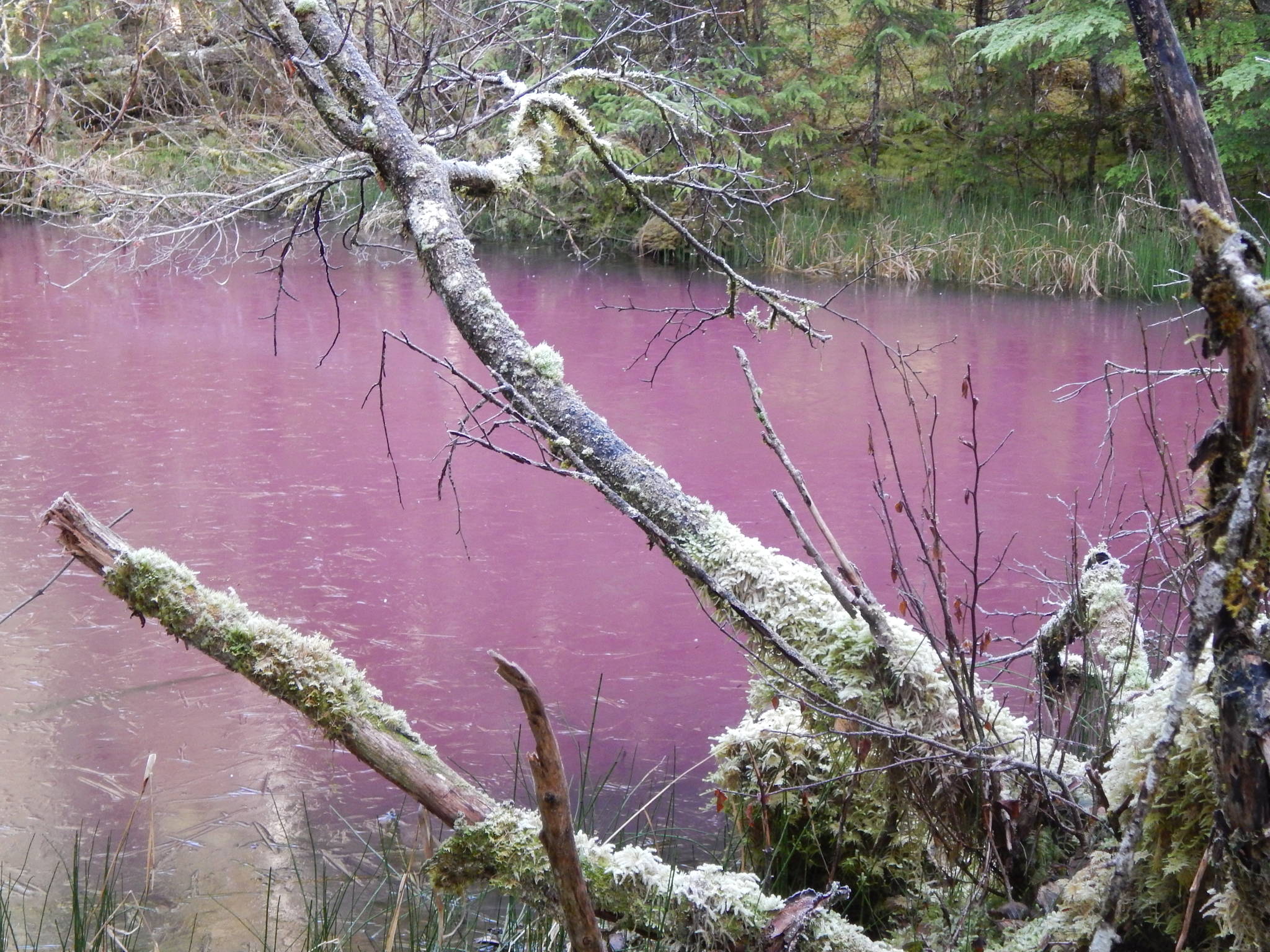University of Alaska Southeast student Jenae Kesey was on a bike ride with her mom and dad last Saturday on Herbert Glacier Trail when she stumbled upon something she’s never seen before: A pond glowing bubblegum pink.
“I thought it was a joke at first, like a prank because it was just Halloween,” Kesey said in a Wednesday phone interview. “It was so random, we thought ‘Why would it be just this one spot?’”
Kesey, a business major with a biology minor, thought at first that it was possibly an algae bloom. To try and rule out the prank angle, she poked around the lake a bit, but couldn’t find any evidence: no can of dye, nothing odd or disturbed about the pond.
Kesey posted photos to Facebook, where several commenters agreed that it looked like an algae bloom. Others offered up the hypothesis that the pink color could come from tracer dyes possibly used by a mineral exploration company which conducted research this summer upriver from Kesey’s pink pond.
Tracer dyes have a lot of applications. Oceanographers use them to track ocean currents and resource companies use them to find out where a water runoff might end up. The general public might use a tracer dye to investigate a problem with a septic tank or to investigate an auto leak. Tracer dyes are used to color the Chicago River green during Saint Patrick’s Day.
In Alaska, they’ve been used to study flows on the Matanuska River and to study how water flows beneath glaciers. Tracer dyes are usually biodegradable and come in bright orange, red or fluorescent colors. Some are undetectable unless put under special lighting.
Grande Portage Resources LTD, the company which just wrapped up their most recent round of exploratory drilling near Herbert Glacier, is a small, Vancouver-based outfit. They’re what’s called a “junior” mining company: they look for mineral resources, in this case gold, document them and sell claims to larger companies.
CEO Ian Klassan was out this week until after press time, but CFO Michele Pillon said she’s not aware of any dye tracing program connected to the exploration. She also hasn’t seen dye tracers used in her 12 years in the mining industry.
Guy Archibald, Southeast Conservation Council’s mining and clean water coordinator, keeps close track of the Herbert Glacier exploration. He said it’s unlikely, given the fact that the pond was the only one in the area to turn this color, that the color change was due to dye tracing.
The pond is also on the other side of Herbert River and downstream quite a way from the center of the drilling. There are many ponds in the area, and it’s unlikely that tracer dye would pool completely in one of them without coloring others.
Unfortunately, the Empire couldn’t completely rule out tracer dyes, as Pillon couldn’t be 100 percent positive they weren’t used in the Herbert Glacier gold exploration. The contractors working with Grande Portage also declined to comment; they were too busy at a mining conference to track down a definitive answer. The U.S. Forest Service’s mineral office for the Tongass National Forest, where the Herbert Glacier drilling occurred, was unavailable as of press time. The Empire will update this story if we get a clearer answer about tracer dyes.
So, what else could cause a pond to turn the color of saltwater taffy?
The Alaska Department of Fish and Game Habitat Biologist Kate Kanouse said ADF&G got wind of the pink pond about a month ago from a former employee. They hope to send a biologist out next week to take a water sample.
Kanouse said she’s not an algae taxonomist, but after pulling together some information and conferring about the pond with colleagues, she said that, if it’s not a tracer dye, one of two things could have caused the pond to turn pink: an algal bloom or something called “cyanobacteria,” a plant-like type of bacteria that grows using photosynthesis.
When conditions are just right, usually when certain elements like nitrogen and phosphorus are present, algae blooms can color large areas of water.
“They use those elements to grow faster and divide and before you know it you have an algal bloom,” Kanouse said in a Thursday interview. Warmer summers lead to more algal blooms.
The pond was much less pink on Wednesday when the Empire visited, which Kanouse said could be more evidence the culprit could be algae.
“I wasn’t surpised to hear you say that it’s much less pink now,” she said. “It’s largely temperature-driven.”
We often see green algae blooms in Southeast, Kanouse said, but pink isn’t out of the question. Fish &Game has studied salmon on Herbert River, but they don’t have data on algae blooms in the area.
Cyanobacteria could also be the culprit. Cyanobacteria can be toxic. They’re suited to stagnant and slow moving waters. They used to be referred to as “blue-green” algae, but in modern usage, the term algae is restricted to
“While (cyanobacteria) can control their buoyancy and move up and down in the water column to find their perfect niche — the warmer groundwater perhaps right now versus warmer surface water perhaps in the summer — they don’t do well in currents, they get washed down stream really quickly, they don’t thrive in riverine systems, so we find them mostly in these isolated ponds,” Kanouse said.
• Curious by Nature answers reader-submitted questions about Mother Nature in Juneau and Southeast Alaska. Ever wonder why Juneau’s water get so much murkier in the summer? Just how fast is the Mendenhall Glacier melting? Is the Fukushima disaster hurting Juneau’s salmon stocks? Why your dog loves the smell of bear poop? Submit your question to outdoors@juneauempire.com and we will scour mountains, rivers, labs and university hallways to try to find the answer. You can also contact reporter Kevin Gullufsen directly at 523-2228 or kevin.gullufsen@juneauempire.com.

